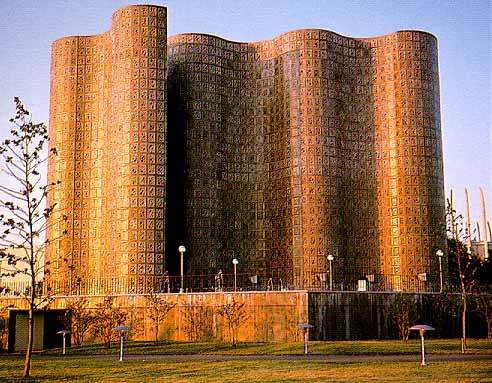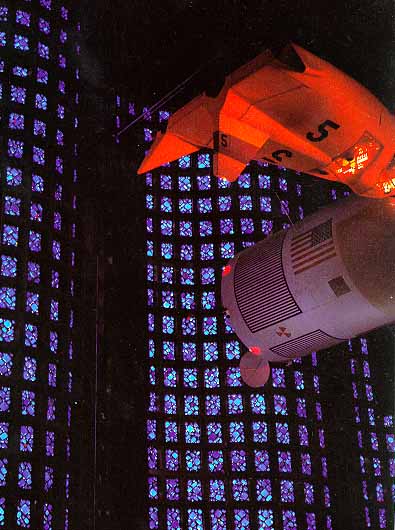Hall of Science
In one big pavilion, 11 companies and organizations presented displays devoted to recent and imminent advances in scientific knowledge. The building, a permanent structure was intended to become the New York Museum of Science and Technology after the fair ended.
| Exterior view of the Hall of Science. |
Exhibit Highlights
A Journey Into Space This exhibit in the Great Hall was presented by the Martin Marietta Corporation. Through the use of motion pictures and sound effects they showed a supply vehicle blasting off from Earth to dock with a space staion in orbit 350 miles away; actually about 50 feet above the floor.How the Brain WorksThe process of sensory perception was traced through a human "brain" made of aluminum disks, 38 miles of wire and 30,000 blicking lights. The exhibit, prepared by the Upjohn Company, demonstrated the complex cerebral procedures involved in a simple decision to applaud the performance of a singer.
The Way We HearAn exhibit epained every aspect of hearing, including the social and physical problems and the efforts of science to solve them. Sponored by the Hearing Aid Industry.
Chemical ManAbbott Laboratories showed a 15 minute movie about the human body and its cellular structure. The film, projected on the floor of an egg-shaped auditorium, was complemented by colored models of molecules of a cell.
A Color CenterThe world of color was depicted by the Interchemical Corporation in a number of displays, including a red, blues and green top that turned white as it spun, and moving objects that changed as they passed through different kinds of light.
Atoms for ChildrenIn "Atomsville U.S.A.," the U.S. Atomic Energy Commission presented an explanation of nuclear energy. The display contained exhibits as a remote controlled manipulator designed for the handling of radioactive substances. Youngsters 7-14 could opearate it themselves. There were also adult diaplays of atomic energy's value in research, agriculture and medicine.
The Chemistry of OceansBoth sound and photographs were used by the American Chemical Society to describe the techniques being developed to uncover the oceans' rich resources of chemicals and minerals.
Flight ControlA model air terminal with moving planes and a control tower demonstrated some of the electronic devices that guided the landing of aircraft.
The War Against CancerThe exhibit by the American Cancer Society demonstrated the importance of cancer research. It showed the story of a major lifesaving cancer detection test.
The Diagnosis of DiseaseAnimated models and diagrams in the display of the Ames Company showed how chemical and electronic detection helped diagnose diabetes, gout and other diseases.
The Chemistry of ColorAn exhibit presented by the General Aniline and Film Corporation showed contributions made in organic chemistry by scientists working in dyestuff research.
 |
A supply ship docks with an orbiting space ship in the building's Great Hall. |